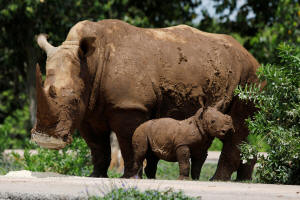|
For
starters, he's cute. Baby rhinos look similar to adults, but
have a stub in place of the horn and thus, are more docile in
appearance.
But the white rhino is also a threatened species, and zoos the
world across have been asked to reproduce them in captivity in
the hope of creating a gene bank that will help preserve the
species should it go extinct in the wild.
"It is a great privilege for us to be able to contribute to the
rescue of a species as threatened as the white rhinoceros," said
Alexander Arango, a Cuban zoo specialist in exotic wildlife, as
he watched the newborn graze on a patch of grass beside his
mother, Katherine.
Cuba, says Arango, now has the second largest population of
white rhinos of any zoo in Latin America - a total of 8 - thanks
to Ale and the birth of his sister, Mel, in 2019. Before that,
it had been nearly two decades since the previous birth.
In a Caribbean island nation with limited resources and far from
Africa, the increasing success in reproduction is a point of
pride, the zookeepers told Reuters.
White rhinos, among the largest land mammals, have suffered in
recent years as poaching has increased across their home range,
primarily across southern Africa. That has put more pressure on
zoos to maintain the species, the zookeepers said.
Cuba's National Zoo is a favorite attraction for Cubans, with
1,473 specimens of more than 120 species, including large
animals such as elephants, rhinos and giraffes.
(Reporting by Reuters TV; writing by Dave Sherwood; Editing by
Sandra Maler)
[© 2022 Thomson Reuters. All rights
reserved.] Copyright 2022 Reuters. All rights reserved. This material may not be published,
broadcast, rewritten or redistributed.
Thompson Reuters is solely responsible for this content.

|
|




